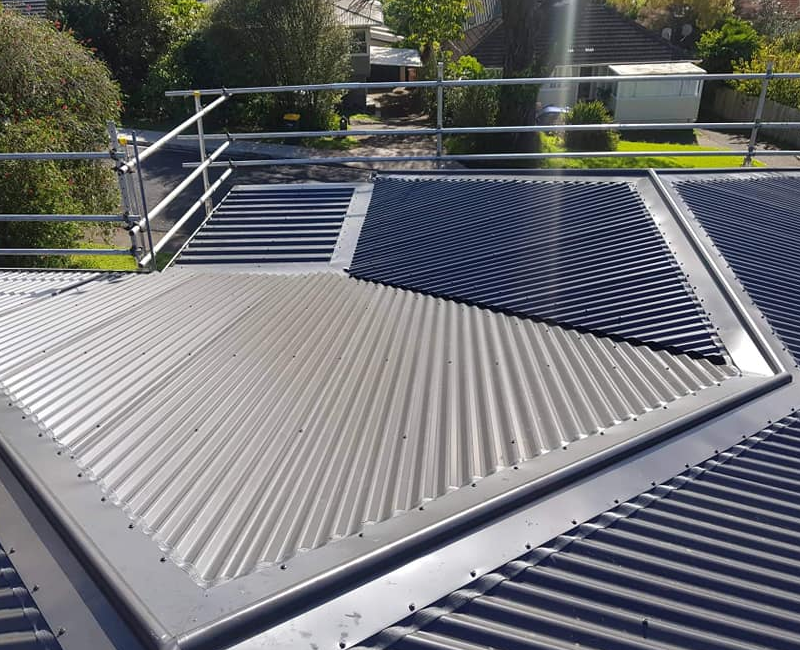Upgrade your roof with a tile-to-steel re-roof in Auckland. Johnson Roofing delivers weight savings, seismic safety, and fascia/spouting improvements.
A tile-to-steel re-roof is an effective solution for homeowners seeking to replace heavy, ageing concrete or clay roof tiles with lightweight, durable long-run steel roofing. This process enhances a property’s appearance while boosting its structural strength and long-term resilience. For homes across New Zealand, transitioning from tiles to steel offers significant advantages that go beyond surface-level upgrades.
Why Consider Re-Roofing from Tile to Steel?
Older tiled roofs often become susceptible to cracking, shifting, and water ingress over time. They are also heavy, placing continuous stress on the underlying roof structure. By contrast, modern long-run steel roofing systems are designed for durability and low maintenance, making them well-suited to New Zealand’s diverse weather conditions.
Opting for a tile-to-steel re-roofing offers homeowners long-term value. Steel roofing is resistant to moss and mould, requires minimal upkeep, and provides a sleek, contemporary appearance. Furthermore, this type of re-roofing can help prevent costly structural repairs that often arise from the ongoing weight burden and water damage associated with tile roofs.
Explore 14 roofing materials for Australian homes on Archipro to find more options.
Weight Savings: A Lighter Load for Your Home
• Significant Reduction in Roof Weight – One of the most notable benefits of a tile-to-steel re-roofing is the substantial weight reduction. Steel roofing weighs just 5–10 kg/m² versus up to 60 kg/m² for tiles, significantly reducing the load on the home’s structural framework.
• Less Structural Strain, Lower Maintenance Costs – By removing the heavy weight of tile, homeowners can reduce long-term strain on their property’s framework. This helps prevent structural damage, extends roof lifespan, and allows quicker, safer installation that reduces future maintenance and labour costs.
Seismic Safety: Improved Earthquake Performance
• Enhancing Structural Resilience – In earthquake-prone New Zealand, a tile-to-steel re-roofing boosts seismic resilience by reducing the roof’s weight and structural stress.
• Reducing Inertia and Risk During Earthquakes – A lighter steel roof cuts seismic force on structures, reducing earthquake damage and aligning with modern safety-focused building practices.
How Tile-To-Steel Conversions Affect Fascia Boards and Gutter Systems
When undertaking a tile-to-steel re-roof, it is important to assess the condition of the existing fascia boards and guttering (spouting). The change in roof profile and weight distribution can affect how these components perform.
Consider the following:
• Fascia alignment: The removal of tiles may expose damaged or misaligned fascia boards that should be repaired or replaced.
• Spouting compatibility: Steel roofing typically requires different guttering profiles to ensure efficient water runoff.
• Upgrade opportunity: Addressing fascia and spouting during re-roofing helps achieve a seamless, watertight finish and reduces future maintenance needs.
Secure Your Home’s Future with a Tile-to-Steel Re-Roof by Johnson Roofing
A tile-to-steel re-roof offers substantial benefits, including weight savings, enhanced seismic performance, and the opportunity to improve fascia and spouting systems. Johnson Roofing delivers professional re-roofing services tailored to meet New Zealand’s unique environmental and structural requirements. With a focus on quality workmanship and durable materials, our team ensures that every project enhances both the safety and value of your home.
Contact us today to arrange a professional assessment and discover how a tile-to-steel re-roofing can protect and transform your property for years to come.
Related Blog Articles:
Residential Re-Roofing Made Easy: Why Metal Roofing Reigns in Auckland
Auckland Re-Roofing Services: Upgrade Your Home or Business with Confidence

